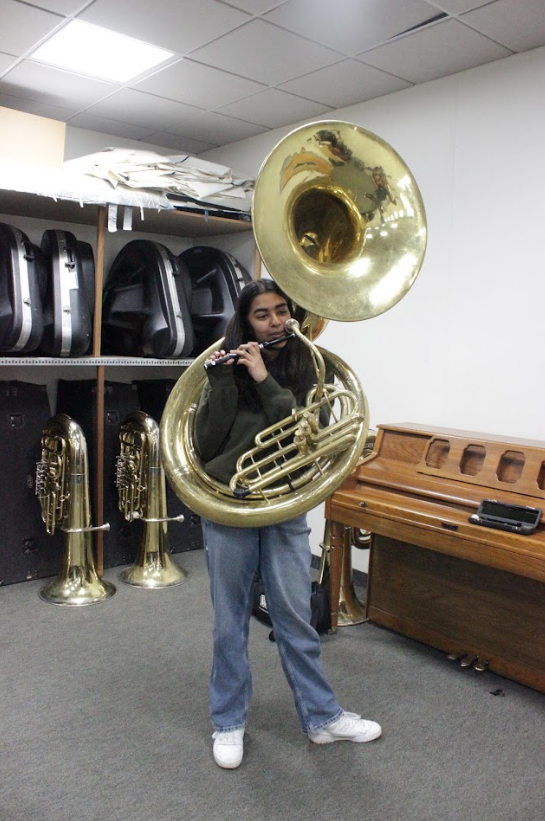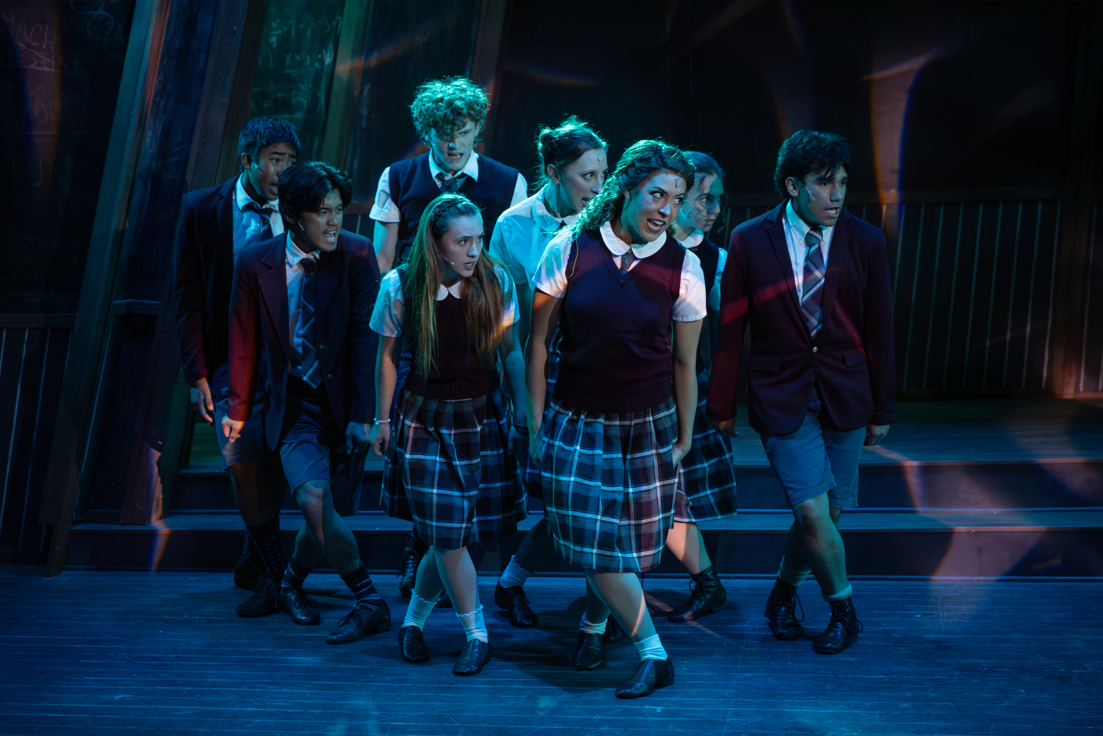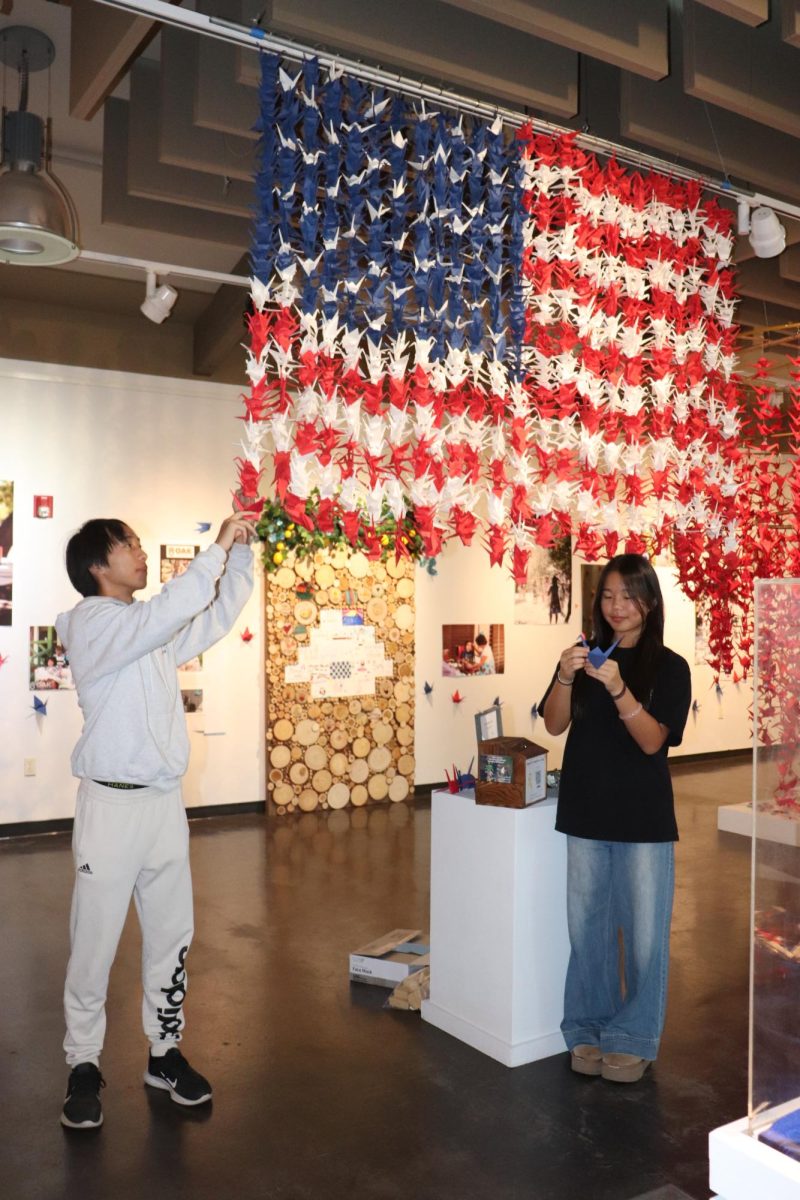
A 10-year-old Maya Keyal (11) would’ve never imagined that she would play an instrument bigger than a flute. After all, along with the flute’s graceful sound, she had picked the flute for its light weight.
But, just a week before her freshman year of high school, she was presented with the opportunity to learn a new instrument for the school band’s marching season. It was an instrument more than half her size, roughly 27 times heavier than her flute, and with a bell the length of her arm: the tuba.
“They needed help with the section and they wanted a lot more people, so I decided to switch,” Keyal said. “Another reason is that as a bass instrument, you’re the foundation that the other instruments listen to in order to play the right things. What you play kind of sets the tone for the band.”
To prepare for the marching season, Keyal had to learn how to play the tuba, all while keeping up with the marching routine.
“It took a while to learn,” she said. “I couldn’t play a note for about a month, and I had to learn as the season went on, which was difficult because it gets busy even if you’ve pretty much mastered your instrument. Having to learn an instrument on top of that was pretty difficult. It was frustrating learning tuba at first because as someone who could play the flute pretty well, I didn’t like going back to the basics of learning how to play a note or getting it in tune.”
Keyal said that the tuba is played inherently and drastically different from the flute. Because the tuba only requires three fingers, the amount of air you blow into the mouthpiece has a big impact on each note.
“The fingerings are not even close to being the same thing,” she said. “One of the crazy differences is that tuba uses something called partials, where when you finger the same note, a bunch of different pitches can come out. Your air angle, how [tight] your jaw is, your air speed, or the temperature of your air all contribute to what note the brass instrument plays. That was just a whole different aspect of a brass instrument I had to learn because on the flute, each fingering is an individual note.”
With the switch from her one-pound flute to the 30-pound tuba, Keyal also had to adjust to the weight difference.
“It was definitely physically harder because you’re carrying 30-35 pounds,” Keyal said. “It’s a big adjustment because it’s a lot more tiring and it really hurts your shoulder because the entire instrument is weighing on your left shoulder. Marching is hard enough, and adding 30 pounds, that’s not easy.”
In addition to fellow band members who helped her learn to play, Keyal said she relied on her musical knowledge of what each note is supposed to sound like: something she learned over her years of playing the flute.
“My section leader, Jaden Nisperos (’24), helped a lot because he was very good at tuba, and then we had coaches who came and gave actual professional feedback,” she said. “But also, I had the knowledge of what a tuba should sound like, I was able to learn it somewhat on my own and be like, ‘That doesn’t sound right,’ so I was able to fix a lot of my mistakes on my own.”
After two years of playing tuba, Keyal was chosen to be section leader this year. However, after marching season finished and concert season began, she switched to playing the flute and the piccolo.
Keyal said that she works on her fundamentals to keep up with the piccolo and flute during the marching season.
“It’s hard to adjust because I’m so used to tuba [during marching season], that practicing on flute or piccolo feels a little weird,” she said. “But just practicing my fundamentals, doing a lot of warm-ups with long tones, and really simple exercises helps me stay connected to the flute during marching season.”
Even though it’s hard to balance the three instruments, Keyal said she feels that playing multiple instruments has made her a better musician.
“Especially because [tuba and flute] are polar opposites, I have perspective on what it feels like to be part of the low group that serves as the foundation, but also the high group that plays the melodies,” Keyal said. “Since I have perspective on both, when I’m playing piccolo, I can hear more from the tubas and respond to their harmony, or when I’m part of the tubas, I can respond more to the flute melody. It’s really good to be able to listen to other people play when you’re playing as an ensemble.”
Because she plays both the melody and the low notes, Keyal said that she’s gained a better understanding of how different instruments blend together.
“They’re both fun in their own way,” she said. “The faster notes of the melody are fun, but then when you play the low notes, you get to hear a lot of the harmonies. I think it’s changed me as a musician because it’s made me understand how classical music works and [has given me] a better idea of the specific role each instrument plays in an ensemble. ”
Keyal said that even though she loves playing her instruments, one of the main reasons she continues with band is because of the close friendships she’s made.
“I feel like the community is so tight-knit,” she said. “We’re all kids who have a place to go at the end of the day, and we all have the same passion for music, and so I think it’s just easy to connect with people because we all have that similarity. Now I don’t play it so much for the instrument, although I do love music. Now I play it a bit more for the experience with the people I’ve gotten to know throughout the years.”





